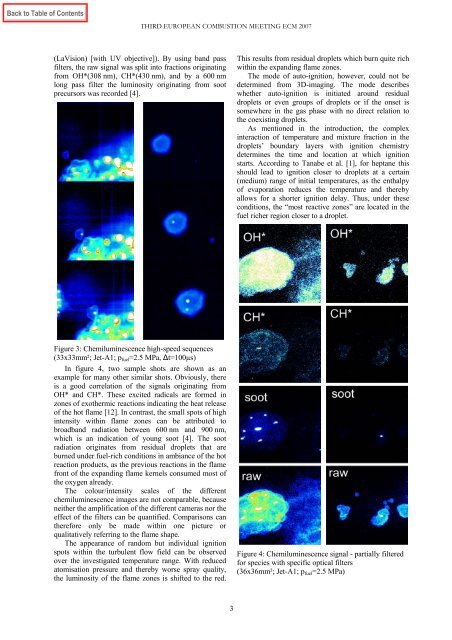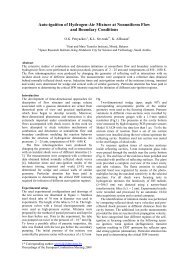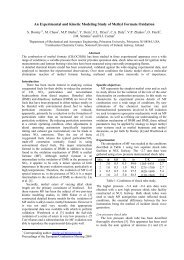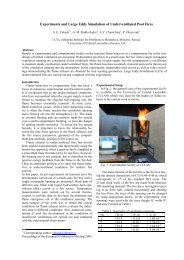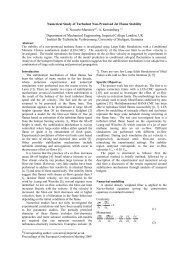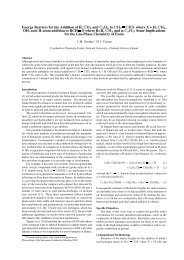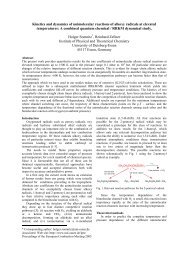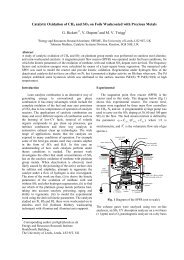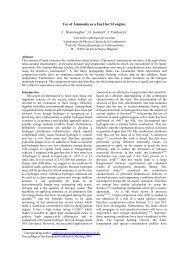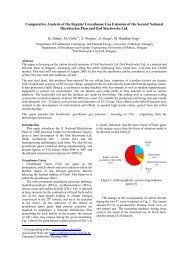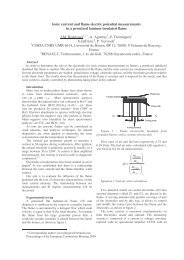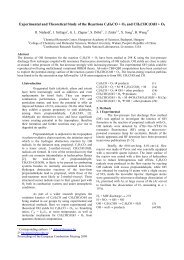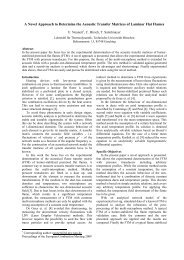Laser based study of auto-ignition of sprays in a continuous flow ...
Laser based study of auto-ignition of sprays in a continuous flow ...
Laser based study of auto-ignition of sprays in a continuous flow ...
Create successful ePaper yourself
Turn your PDF publications into a flip-book with our unique Google optimized e-Paper software.
THIRD EUROPEAN COMBUSTION MEETING ECM 2007<br />
(LaVision) [with UV objective]). By us<strong>in</strong>g band pass<br />
filters, the raw signal was split <strong>in</strong>to fractions orig<strong>in</strong>at<strong>in</strong>g<br />
from OH*(308 nm), CH*(430 nm), and by a 600 nm<br />
long pass filter the lum<strong>in</strong>osity orig<strong>in</strong>at<strong>in</strong>g from soot<br />
precursors was recorded [4].<br />
This results from residual droplets which burn quite rich<br />
with<strong>in</strong> the expand<strong>in</strong>g flame zones.<br />
The mode <strong>of</strong> <strong>auto</strong>-<strong>ignition</strong>, however, could not be<br />
determ<strong>in</strong>ed from 3D-imag<strong>in</strong>g. The mode describes<br />
whether <strong>auto</strong>-<strong>ignition</strong> is <strong>in</strong>itiated around residual<br />
droplets or even groups <strong>of</strong> droplets or if the onset is<br />
somewhere <strong>in</strong> the gas phase with no direct relation to<br />
the coexist<strong>in</strong>g droplets.<br />
As mentioned <strong>in</strong> the <strong>in</strong>troduction, the complex<br />
<strong>in</strong>teraction <strong>of</strong> temperature and mixture fraction <strong>in</strong> the<br />
droplets’ boundary layers with <strong>ignition</strong> chemistry<br />
determ<strong>in</strong>es the time and location at which <strong>ignition</strong><br />
starts. Accord<strong>in</strong>g to Tanabe et al. [1], for heptane this<br />
should lead to <strong>ignition</strong> closer to droplets at a certa<strong>in</strong><br />
(medium) range <strong>of</strong> <strong>in</strong>itial temperatures, as the enthalpy<br />
<strong>of</strong> evaporation reduces the temperature and thereby<br />
allows for a shorter <strong>ignition</strong> delay. Thus, under these<br />
conditions, the “most reactive zones” are located <strong>in</strong> the<br />
fuel richer region closer to a droplet.<br />
Figure 3: Chemilum<strong>in</strong>escence high-speed sequences<br />
(33x33mm²; Jet-A1; p fuel =2.5 MPa, ∆t=100µs)<br />
In figure 4, two sample shots are shown as an<br />
example for many other similar shots. Obviously, there<br />
is a good correlation <strong>of</strong> the signals orig<strong>in</strong>at<strong>in</strong>g from<br />
OH* and CH*. These excited radicals are formed <strong>in</strong><br />
zones <strong>of</strong> exothermic reactions <strong>in</strong>dicat<strong>in</strong>g the heat release<br />
<strong>of</strong> the hot flame [12]. In contrast, the small spots <strong>of</strong> high<br />
<strong>in</strong>tensity with<strong>in</strong> flame zones can be attributed to<br />
broadband radiation between 600 nm and 900 nm,<br />
which is an <strong>in</strong>dication <strong>of</strong> young soot [4]. The soot<br />
radiation orig<strong>in</strong>ates from residual droplets that are<br />
burned under fuel-rich conditions <strong>in</strong> ambiance <strong>of</strong> the hot<br />
reaction products, as the previous reactions <strong>in</strong> the flame<br />
front <strong>of</strong> the expand<strong>in</strong>g flame kernels consumed most <strong>of</strong><br />
the oxygen already.<br />
The colour/<strong>in</strong>tensity scales <strong>of</strong> the different<br />
chemilum<strong>in</strong>escence images are not comparable, because<br />
neither the amplification <strong>of</strong> the different cameras nor the<br />
effect <strong>of</strong> the filters can be quantified. Comparisons can<br />
therefore only be made with<strong>in</strong> one picture or<br />
qualitatively referr<strong>in</strong>g to the flame shape.<br />
The appearance <strong>of</strong> random but <strong>in</strong>dividual <strong>ignition</strong><br />
spots with<strong>in</strong> the turbulent <strong>flow</strong> field can be observed<br />
over the <strong>in</strong>vestigated temperature range. With reduced<br />
atomisation pressure and thereby worse spray quality,<br />
the lum<strong>in</strong>osity <strong>of</strong> the flame zones is shifted to the red.<br />
Figure 4: Chemilum<strong>in</strong>escence signal - partially filtered<br />
for species with specific optical filters<br />
(36x36mm²; Jet-A1; p fuel =2.5 MPa)<br />
3


